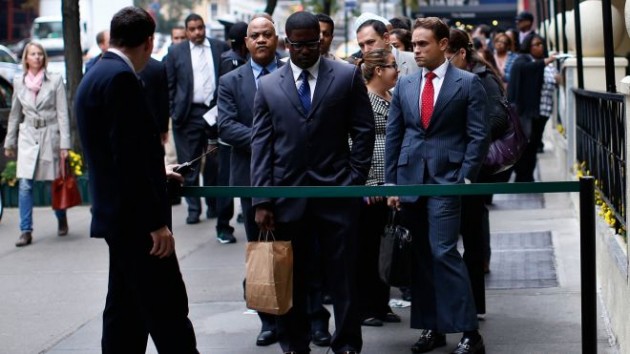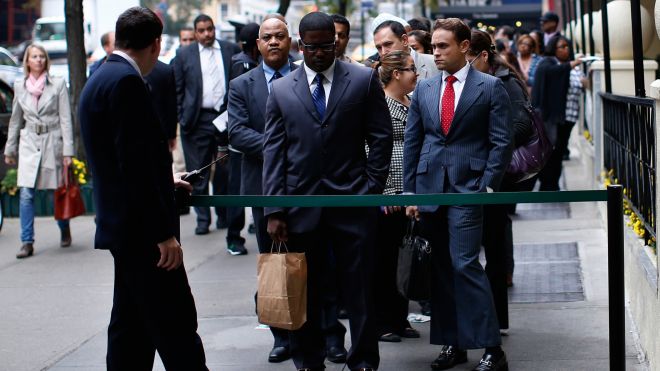

Job seekers navigate through a weak labor market and teetering economy. (Photo: REUTERS)
The U.S. economy added 288,000 private-sector jobs in the month of June, while the unemployment rate dropped by 0.2 percentage point to 6.1 percent. Economists had forecast 212,000 new jobs and that the unemployment rate would hold steady at 6.3 percent.
But inside the June jobs report from the Bureau of Labor Statistics are concerning numbers that show the headline unemployment rate is extremely misleading until you dig into the data.
Much of the growth came from professional and business services, retail trade, food services and drinking places, as well as health care. The number of unemployed persons decreased marginally but remains at an abysmal 9.5 million, while the number of long-term unemployed (those jobless for 27 weeks or more) in June was still 3.1 million. Long-term unemployed individuals accounted for just 32.8 percent of the total number of unemployed individuals counted in the headline unemployment rate.
The civilian labor force participation rate in June remained stubbornly high at 62.8 percent for the third consecutive month. Meanwhile, the under-reported employment-population ratio, which is a measurement of the number of able-bodied Americans actually in the labor market, is at a pathetic 59.0 percent. Sadly, that number rose by just 0.3 percentage point over the entire year. Much of the number representing those who re-entered the workforce stems from either part-time employment or low-paying jobs.
The number of persons employed part-time for economic reasons, or involuntary part-time workers, increased by 275,000 in June to 7.5 million. These Americans were working part-time because their hours had been cut back, which is a known consequence of ObamaCare as employers attempt to compensate for excessive cost burdens, or because they were unable to find a full-time job.
In June, 2.0 million persons were marginally attached to the labor force, but are not counted in the headline unemployment rate even though they were not in the labor force, wanted and were available for work, and had actively looked for a job a some point during the past 12 months. But, because they had not look over the past 4 weeks, they are excluded from the misleading measurement.
The latest jobs report adds pressure to Fed Chair Janet Yellen to begin to start lifting interest rates and end money-printing policy, known as quantitative easing. “Yellen is not going to be able to wait until May 2015 to raise rates and that is what the U.S. Treasury market is responding to today,” Peter Boockvar, chief market analyst at The Lindsey Group said in an email.
Yellen, however, just said in a speech Wednesday that she isn’t concerned about money-printing and low rates causing inflation or future asset bubbles, despite the data. Inflation remains below the Fed’s 2 percent target rate and is now a primary indicator of whether the Fed will tighten future monetary policy. Prior determinations were predicated on the labor market, which showed sputtering growth at best until these past few months.
Still, if labor markets demand more workers, as is the case when so many Americans have simply quit looking for work altogether, the demand will increase wages. The real unemployment number came in at 12.1 percent, including those who are part-time and have quit on the American dream. Typically, the economy needs higher wages to begin to see higher prices, or inflation. But inflation, though below the arbitrary target, has risen steadily regardless. That’s what Yellen is waiting on, according to most analysts.
The consensus among Fed policy-makers remains that rates will not begin to move higher until mid-2015, but there is no doubt increasing pressure is mounting to move up the date to the first quarter of 2015. The yield on the 10-year Treasury bond rose 0.04 percentage point to 2.67 percent following release of the June jobs report.
While it is true that the U.S. economy has now seen five consecutive months of job creation north of 200K, there are two serious concerns remaining. First, if the economy hopes to simply keep pace with population increases, then at least 250,000 jobs must be added monthly, which has not happened.
Second, the U.S. economy contracted by 2.9 percent last quarter, which was the largest contraction outside of a recession period. That means the economy must grow at nearly 3 percent this quarter if it hopes to clock in at zero growth on a yearly basis. If past performance over the past six years is any indication of future performance, then this is an unlikely feat.





